|
< Earlier Kibitzing · PAGE 7 OF 9 ·
Later Kibitzing> |
Jun-12-11
 | | An Englishman: Good Evening: This one might be a little too famous to be of much use for a Sunday. Incidentally, the two possible improvements mentioned by <nezhmet> look interesting. What sayeth the monsters of silicone? |
|
| Jun-12-11 | | rhickma4: The first move looks straightforward for Sunday: after that it gets complicated.
21.Bg6 exposes Black Q as well as threatens 22.Bf7+
Black has many possible responses
21...Qxd1 22.Re6+ Ne7 23.Rexe7+ Kf8 23.Bxh6+ Kg8 24.Bxf7++
21...Nxe3 22.Bxf7+ Kf8 23.Qxd4 Rxd4 24.Bxe3 and black has no way to save the R and prevent 25.Bxh6++
21...Qf4 22.Re6+ Kg8 23.Bxf4
21...Qe3+ 22.Bxe3 h(or f)xg6 23.Bd5 leaves White with a winning advantage
21...c5 22.Qxd4 cxd4 23.Rxe6 etc
21...Qc5 22.Bxf7+ Kf8 23.Ba3 winning the Q
21...Qf6 22.Bxf7+ Qxf7 23.Rxf7 Nxe3 24.Qxd8 Kxd8 25.Bxe3 Bh3 26.Rxa7 followed by Rxh7 looks like a winning end for white
21...Qg7 22.Rxe6+
21...Nf4 22.Qxd4 Rxd4 23.Bxf7 Kf8 24.Ba3+ Kg7 25.Bb2 pinning the rook
21...Nc7 22.Qxd4 Rxd4 23.Bxf7+ Kxf7+ 24.Rc7+ followed by Kxg2
I can't see any other options for Black. |
|
Jun-12-11
 | | Phony Benoni: 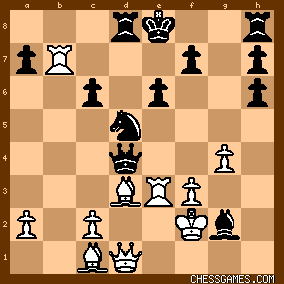
click for larger view<21.?>
For Anand, it's not a question of seeing the winning shot here. He must have anticipated it a few moves ago. But how can the average player comprehend it? First the basics. Black is two pawns ahead, and threatening to win the exchange. His king is caught in the center, but White's seems no better off. Black's biggest liability is the stranded bishop on g2. If White can survive the current mess, maybe pick up a pawn or two, he is probably going to be able to win a piece in the end. Also, White is practically a piece ahead for attacking purposes, indicating that something could well be available. Tactically, what immediately catches the eye is the W♕d1/W♗d3 against an unprotected B♕d4. We've seen it dozens of times; bishop gives check with discovered attack, wininng the queen. Unfortunately the bishop has no checks at the moment, but we don't actually need one if we can move the bishop and create a threat bigger than losing the queen. 21.Bb5 is a possibility, but not a big enough one after 21...Qxd1 22.Bxc6+ Kf8 and Black's king escapes via g7. For something like this to work, the ♗c1 must check on h6, but the rook is in the way. That suggests that we need to find a way for Rxe6+ to work, and it appears that 21.Bg6 can set this up by pinning the f-pawn, allowing 21...Qxd1 22.Rxe6+ Ne7 23.Rb/Rexe7+ Kf8 24.Bxh6+ Kg8 25.Bxf7#. If Black tries to maintain the pin on the rook with 21...Qc5, than 22.Bxf7+ Kf8 23.Ba3, and we have the odd situation where the pinned rook actually does protect the pinning bishop. If you're into the full credit thing, you'll want to see 21...Ne7 and calculate that White's best is simplifying and winning the ♗g2. That's for good players. The important thing for the learning player is to recognize the pattern on the d-file as a signal, and to find out that the pattern can be utilized in a different way than usual. |
|
| Jun-12-11 | | rhickma4: Idea was right, but missed the game continuation! |
|
| Jun-12-11 | | mario1031: hi all, question (and there's probably an easy answer, as i too often miss the obvious:)) i did look over the 7 pages of kibitzing to see if it was asked and although i did see 21...Nxe3 suggested & refuted yet what about 21...Qxe3+? if followed by 22.Bxe3 hxg6 does black have any hope? i read rhickma4 comment that W has winning chances after this line with 23 Bd5(?)did you mean 23. Bd4?) but nothing deeper. Anyway, i enjoy the site & comments.
Thanks. |
|
| Jun-12-11 | | consul: <An Englishman> is right about the fame of this game.
Though, trying to think what happens if White plays Bg6 before h6: find the difference, i can't!
Does anyone have a clue?
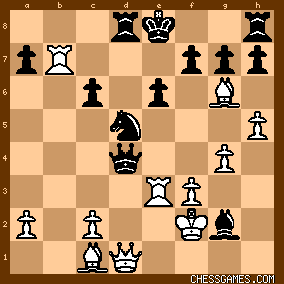
click for larger view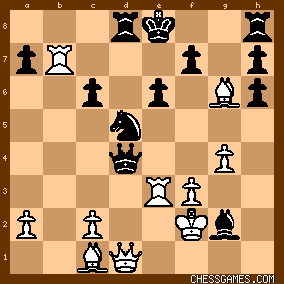
click for larger view |
|
| Jun-12-11 | | sevenseaman: Its a crazy game of the sitting WC. Its part of my No.1 collection and it
will be preposterous to suggest I found the solution. Two minutes of looking at it and I remembered on a/c of that useless Black
B sitting at g2. It sat there for many moves and nobody wanted it. I
immediately knew Anand did something much more dynamic. Now what was it? Yah, he threatened mate, forsaking his Q. He went Bg6,
leaving his Q en pris. Vishy's Q is however immune because the impending mate combo Bxf7+ and Ba3# is more imperative. Dealing with it means Lautier had to give up his own Q. I think he played
a face-saving Ne7 and the game drifted away from Lautier. <21. Bg6 Ne7 22. Qxd4 Rxd4 23. Rd3 Rd8 24. Rxd8+ Kxd8 25. Bd3 1-0.> is
like how it went.
Looking at the POTD position one could be forgiven for thinking Anand was
in big trouble.
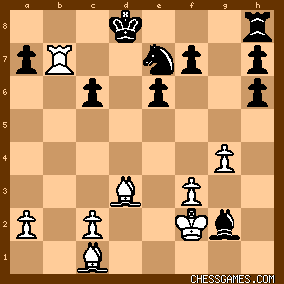
click for larger view |
|
| Jun-12-11 | | chesssantosh: what happens if white plays 20.Bg6 instead of playing h6 first.i dont see any difference.then why did anand waste a move to attack? |
|
| Jun-12-11 | | andrewjsacks: An immortal move. |
|
Jun-12-11
 | | Phony Benoni: <consul> <chessantosh> 20.h6 is a necessary addition to the attack, setting up a check on h6 for the ♗c1. Without it, the continuation would be: <20.Bg6 Qxd1 21.Bxf7+ Kf8 22.Ba3+ Ne7!>
click for larger viewAnd White can do no better than 23.Bxe7+ Kxf7 24.Bxd8+, with some compensation for the material. Not 23.Rxe7 c5 24.Bxc5? Qxc2+. <mario1031> The problem with lines like 21...Qxe3+ 22.Bxe3 hxg6 is that Black must inevitably lose the bishop on g2, leaving him too far behind in material. |
|
| Jun-12-11 | | cormier: maybe 12...Nb6 |
|
| Jun-12-11 | | Jamboree: I saw the Sunday puzzle answer almost immediately (21. Bg6), but that's not what I'm concerned about. What confuses me is instead Anand's 23rd move 23. Rd3. What? It seems so slow and passive considering all the tactics in the position. I was assuming the White would continue either 23. Rxe6!? or the totally obvious 23. Rb8+ Rd8 24. Rxd8+ Kxd8 25. Bxf7. It seems either Rxe6 or Rb8+ also win -- so why play 23. Rd3, which (I may be mistaken) is much less forcing and gives black a chance to wriggle out. Why, for example, didn't Lautier reply 23. Rd3 Rxd3. Where's the forced win after that? And if there is one, is it simpler than the alternative moves I suggest above? |
|
| Jun-12-11 | | M.Hassan: "Insane". White to play 21.?
White has a Bishop for a Knight and is behind by two pawns.Removal of the Bishop on d3 caught my eyes at first. After some hesitation and trying 21.c4 line and not getting much of advantage for White after 10 moves, came back to the Bishop movement and realized that although White looses his Queen but can throw "everything" on Black: 21.Bg6 Qxd1
22.Rxe6+ Kf8 <no defence by Knight nor by pawn>
23.Bxh6+ Kg8
24.Bxf7#
Great win by Mr. Anand |
|
| Jun-12-11 | | M.Hassan: I had only first move right! |
|
| Jun-12-11 | | consul: <Thank you Phony Benoni!>
Now i got back to the right track: with the position of the game, if Black plays Qxd1 White can play 22.Rxe6+ followed by Bxh6# (eventually after a useless interposition with Ne7). I was thinking about it but i was seeing only the rook pinned.
In case Black plays 21 .. Qc5 then 22. Bxf7+, and Ba3, guarded by the rook... which was also another ghost i was worried about... |
|
| Jun-12-11 | | sevenseaman: <Jamboree> <Why, for example, didn't Lautier reply 23. Rd3 Rxd3. Where's the forced win after that? And if there is one, is it simpler than the alternative moves I suggest above?> 23. Rd3 Rxd3 24. Bxd3 Rg8 (otherwise 25. Rb8+ and Black loses his R)
25. Kxg2
Now White has enough for a win? |
|
| Jun-12-11 | | sevenseaman: <M.Hassan> <I had only first move right!> No. I think you had the whole solution if Lautier takes the White Q. The other alternative for Lautier is to not take the Q and defend better. Here are two a lines; a)21... Qf6 22. Bxf7+ Qxf7 23. Rxf7 Nxe3 24. Qxd8+ Kxd8 25. Bxe3 Bh1
26. Rxa7 Re8 27. Bxh6 Kc8 28. Rxh7 e5 29. Be3 Rf8 30. Rxh1. Or b) 21. Bg6 Ne7 22. Qxd4 Rxd4 23. Rd3 Rd8 24. Rxd8+ Kxd8 25. Bd3 1-0. |
|
| Jun-12-11 | | SimonWebbsTiger: confound it -- I knew yesterday's Polugayevsky v. Ftacnik game and I know this one too! dry facts for those who are interested: this game was awarded Informator 71's best game prize with 74/90 points; Nr. 2 only scored 58/90 points. The game is from Informator 70/89.
Anand, in his notes, says 20...Ne3 was Black's only move and provides analysis showing 21. Be3 is "  " " |
|
| Jun-12-11 | | RobertLangdon: After 25.Bd3!
click for larger view
Black resigned in view of 25...Bh1 26.Bb2 Re8 27.Bf6 and zugzwang! |
|
Jun-12-11
 | | Check It Out: A classic. 21.Bg6 is an incredible move. |
|
| Jun-12-11 | | morfishine: <Jamboree> You are right on all points. However, Black's position is totally lost, so it doesn't matter. |
|
| Jun-12-11 | | SimonWebbsTiger: apropos Anand's Informator notes.
He attributes some star moves, hidden in the variations to the game, to Lautier. The trouble is determining when or where Joel suggested the moves? I would guess post-mortem. Any francophiles know if Joel wrote this game up for Europe d'Echecs? So, even though Lautier lost in brilliant style, he - as you would expect - has a keen eye for the beautiful. |
|
| Jun-12-11 | | David2009: Anand vs Lautier, 1997 White 21? Insane I looked first at 21.Re6+ "too easy for a Sunday" before noticing that it is an illegal move. So instead try 21.Bg6 GOOT!
If 21...Qxd1 22.Rxe6+ (now the move is legal) Kf8 24 Bh6+ Kg8 25 Bxf7#. Alternatively 22...Ne7 23 R7Xe7+ Kf8 24 Bh6+ Kg8 25 Bxf7#
If 21...Ne7 22 Qxd4 Rxd4 23 Rxe6 GOOT TWO! (seeing hxg6 24 Rxe7+ Kd8 25 Kxg2 and White is up a Bishop. There may be better for Black in
the GOOT TWO position. Time to check:
====
Bielissima! Bring out the gold pieces!
Well I got the start but missed 23 Rd3! counter-intuitive but very strong. Crafty End Game Trainer link to test the variations:
http://www.chessvideos.tv/endgame-t...
The EGT finds the best defence 21...Qf6! but ends up a Bishop down after a genetral liquidation starting 22.Bxf7+ Qxf7 23.Rxf7 Nxe3 24.Qxd8+ Kxd8 25.Bxe3 Bh1 26.Kg1 Bxf3 27.Rxf3 Rg8 28.Rg3 h5 29.g5 to leave what should be an easy endgame win (with a B for two Pawns) but which I contrived to mess up first time round. Time to check the GOOT TWO:
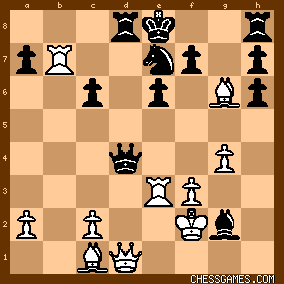
click for larger view (Anand vs Lautier 1997 22?)
The EGT refutes 22.Qxd4 Rxd4 23.Rxe6? with 23...Rdd7 to leave
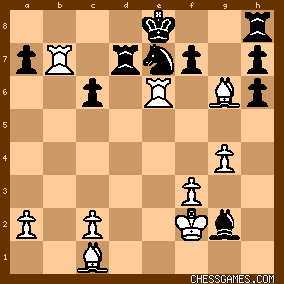
click for larger view
and I have dissipated White's entire advantage: it is prudent to take the draw with 24 Rb8+ Rd8 25 Rb7 UNGOOT! Bah! Instead 23.Rd3! Rxd3 24.Bxd3 wins a piece with no counter-play for Black. |
|
| Jun-12-11 | | CHESSTTCAMPS: White is down two pawns and apparently faces the loss of the pinned rook on e3. However, White has the obvious assets of having a rook on the 7th and an uncastled enemy king for target practice. Furthermore, white's pieces on the middle files, even though they appear to be tied down, are loaded with latent power. My first and only candidate was a quick find, the only offensive option that made sense. 21.Bg6!! immediately unleashes a queen and a bishop, neither of which black can take, and other pieces are released depending on black's defense: A) 21... Qxd1 22.Rxe6+! Ne7 (22... Kf8 23.Bh6+ Kg8 24.Bxf7#) 23.Rb(e)xe7+ Kf8 24.Bh6+ Kg8 25.Bxf7# B) 21... h/fxg6 (or O-O, Rf8) 22.Qxd4 wins.
C) 21... Nxe3 22.Bxf7+ Kf8 23.Qxd4 (I almost fell for 23.Bxe3?? Qxe3+ doh!) Rxd4 24.Bxe3 and the double threat of 25.Bh6# / 25.Bxd4 can't be met. D) 21... Qxe3+ 22.Bxe3 hxg6 (Nxe3 23.Bxf7+ Kf8 24.Qxd8+) 23.Qa1 is devastating but Qg1 should do just fine. E) 21... Qc5 (keeping rook pinned) 22.Bxf7+ Kf8 23.Ba3 Qxa3 (Nxe3 24.Bxc5+) 24.Rxa3 wins. F) 21... c5 22.Qxd4 cd 23.Rxe6+ wins as in A.
G) 21... Nc3 22.Bxf7+ Kf8 23.Qxd4 Rxd4 24.Rxc3 wins.
If there's a robust defense, I'm missing it.
I plan on playing the weekend puzzles again on a more regular basis. Time for review... |
|
| Jun-12-11 | | CHESSTTCAMPS: Did in fact miss the game defense. |
|
 |
 |
|
< Earlier Kibitzing · PAGE 7 OF 9 ·
Later Kibitzing> |





